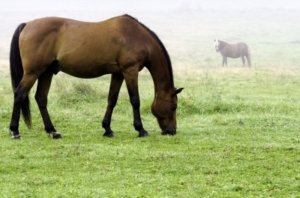Are Grass Clippings Good for Your Horse?
by Eleanor Blazer
You might think feeding lawn clippings to horses makes sense. After all horses are designed to eat grass, but think again.
The sensitive equine digestive system does not tolerate change. Anytime you introduce new feed to a horse it must be added gradually to the diet over a period of 7-10 days. This gives the beneficial microbes and bacteria within the large intestine (cecum) time to adjust to the new diet. Giving your horse a “treat” of grass clippings occasionally does not give him time to adjust.
Most lawns are maintained by frequent fertilization, producing grass that is high in non-structural (soluble) carbohydrates. Feeding horses grass clippings that contain high levels of NSC’s also disrupts the balanced microbial population in the large intestine. Having a weak moment and giving your horse a pile of grass clippings is asking for digestive upset – leading to diarrhea, colic or laminitis.
In addition to fertilizer, many lawns are also treated with herbicides and pesticides. Any homeowner who has read the warnings on these products won’t want to feed the grass to their horse.

When your horse grazes he sorts through the plants – picking the ones he likes, nipping them off, thoroughly chewing and then swallowing – while leisurely moving along. A pile of grass clippings does not give him an opportunity to sort. It allows him to rapidly swallow a large bolus of short-stemmed material. This could lead to choke, a blockage of the esophagus.
Not sorting can also lead to the ingestion of toxic plants. Many ornamental shrubs, which are poisonous to horses, surround homes. A leaf that has blown onto the yard and mixed in lawn clippings is asking for trouble if fed to your horse. Take time to find out if your plants are toxic to horses. Get rid of them if they pose a danger. (Read about oleanders at http://www.thewayofhorses.com/oleander_0607.html.

Broodmare owners have to consider the type of grass in the lawn. Many lawns contain fescue. Fescue is an economical hardy grass that is disease and drought resistant. But lawn fescue contains a hidden danger for broodmares in their last three months of gestation – an entophyte fungus. This fungus can cause prolonged gestation, inhibit development of the udder and restrict milk production.
Entophyte toxicity also causes the placenta to be thick and separate prematurely, a condition called “red bag.” The foal will die if quick intervention is delayed when presented with a red bag delivery. Consult your veterinarian for instructions on how to deal with a red bag birth prior to the foaling date; you will not have time to call for help. Red bag can be caused by things other than entophyte fungus.
Foals may also be born dead or with the syndrome called dysmaturity (dummy foal). Research has also shown the entophyte fungus can delay heat cycles and increase the chance of embryo loss during the first 30-60 days of gestation.
Another problem with feeding grass clippings is the possibility of mold and botulism. Many homeowners like to rake or gather clippings instead of leaving them on the manicured lawn. Piling the moist residue creates heat and fermentation leading to mold. Botulism can also develop. Botulism is a bacterium that grows in decaying vegetation or animal carcasses. Botulism kills horses. For more about botulism and horses go to: http://www.thewayofhorses.com/06_10_botulism_horses.html
As delectable as those lawn clippings may look they can be a life threatening danger; don’t have a “weak moment.”
Published June 2012 Issue

Eleanor Blazer was raised training and caring for horses. She learned to ride and care for the horses her family bought and sold. Many of these horses required improved nutrition when they arrived for training. Eleanor’s experience and research has benefited both horses and horse lovers in the field of equine nutrition. An equine nutrition consultant, based in Bulverde, Texas, she keeps busy doing equine nutrition consultations, conducting seminars, and speaking to youth groups about horse care and nutrition. Eleanor is the author of the syndicated column The Way of Horses. She has more than 20 years experience helping and being a mentor to those wanting to know how to provide the very best care and nutrition for our special friend – the horse.

